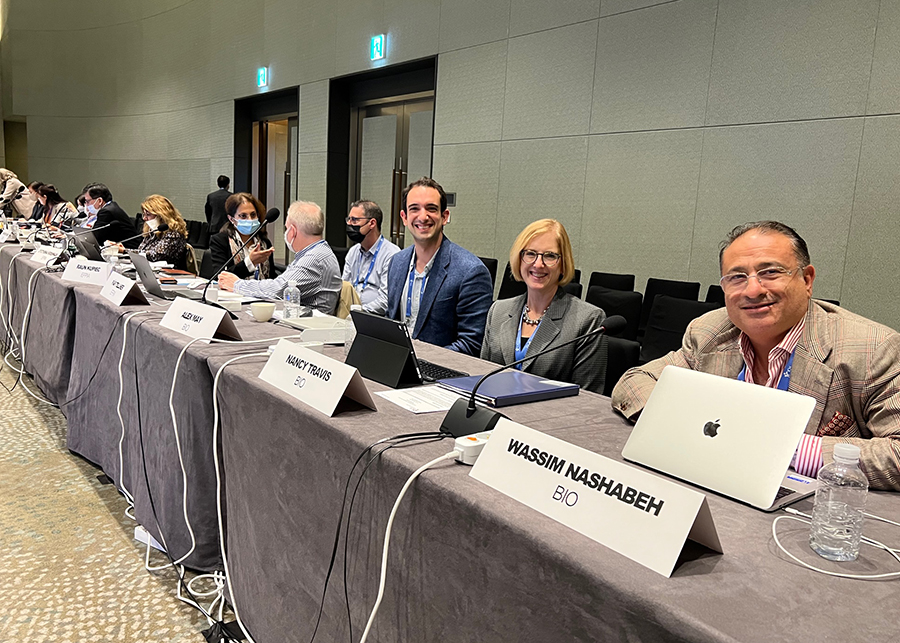The process of holding clinical trials and gaining FDA approval takes up much of the time and expense involved in drug development, which can last for years and cost billions of dollars. Once a drugmaker proves the value and safety of a new medicine to one regulator, they should not have to start all over again before they can reach patients in another country.
That’s the idea behind the International Council for Harmonisation of Technical Requirements for Pharmaceuticals for Human Use (ICH), a global organization seeking to unify drug regulatory processes so that achieving approval in one country makes it easier to achieve approval in several others. The Biotechnology Innovation Organization (BIO) is a long-time member of the ICH, which works by bringing together regulators and the industry in a quest to establish common standards and thereby streamline processes.
“Different countries can have varying requirements,” for drug approval, according to Nancy Travis, BIO’S Vice President for International Affairs. “To the extent that countries can agree ahead of time on a harmonized set of requirements, that’s just going to make it easier and quicker for patients to get access to these new therapies.”
The potential for harmonization to address urgent needs was widely recognized after the advent of the COVID pandemic, but the benefits of harmonization were already well understood by the time the International Conference on Harmonisation, the forerunner to today’s ICH, was founded in 1990. The current ICH was established as an international association in 2015 and BIO joined in 2016.
Latest gathering in Korea
The ICH general assembly meets twice a year, and Travis joined BIO’s delegation to Incheon, Korea, where the latest ICH conference took place in November.
Highlights of that meeting included approval of new guidance on continuous manufacturing, “which is a ground-breaking achievement by ICH because that will inform the way that each individual region sets up its own continuous manufacturing regulatory programs,” according to Alex May, BIO’s Science & Regulatory Director, who was also in the meeting.
Advances in production technology have improved the possibilities for continuous manufacturing of drugs, which involves incorporating all segments of production—including testing, feeding, and processing—inline in one site. This approach can strengthen supply chains and make it possible to achieve quantities of drug production that used to take months in a matter of days. The “Continuous Manufacturing of Drug Substances and Drug Products” guideline approved in Incheon “describes scientific and regulatory considerations for the development, implementation, operation, and lifecycle management of continuous manufacturing,” according to an ICH press release.
May noted that these agreements have become a standard part of ICH’s work. For instance, the idea of good clinical trial practices and good manufacturing practices “are common terms in our field, but they started with ICH,” he said. “These are areas where there have been harmonization guidelines in place for years.”
Other recent milestones noted at the November ICH meeting included progress on guidelines covering:
- A Selective Approach to Safety Data Collection in Specific Late-Stage Preapproval or Post-Approval Clinical Trials.
- Clinical electronic Structured Harmonised Protocol (CeSHarP), Technical Specification and Template.
- Viral Safety Evaluation of Biotechnology Products.
- Testing for Carcinogenicity of Pharmaceuticals.
“When all the ICH members agree on an approach, it really does become the global standard and others will follow. There are a number of areas where this has already been achieved,” May said.
Benefits for BIO members
Establishing one set of global standards eliminates the challenge of navigating dozens of regulatory environments and increases the potential market, and therefore potential returns, for a new drug.
“For small companies, it can be a lifesaver in terms of removing obstacles to bringing therapies overseas,” said Travis. That’s why it is such an important part of the work for an industry association like BIO, she explained.
“BIO’s members are 90% small- and medium-sized companies. They don’t have big regulatory departments, local offices at subsidiaries overseas, or a big staff of lawyers to help navigate the differing regulatory requirements,” Travis said. “Harmonization of regulatory requirements can often determine whether or not they can launch in another country.”
BIO and its members also benefit from having a forum in which they can speak with the regulators. “We can get out ahead of the regulatory process as new therapies and novel treatments are being developed, and sensitize the overseas regulators, as well as the FDA, to any requirements we see emerging. We also can talk with them candidly about whether we think a specific guidance is warranted,” said Travis. “That’s a really important benefit to our members, who are often on the cutting edge of innovation with novel therapies.”
Collaborative approach
According to Travis, the regulators understand that members of the industry have the most knowledge about new developments, and they are eager to benefit from the expertise of BIO and its members.
May noted that the process of working with the ICH on harmonization involves a lot of work from both BIO and its members. “Within BIO, the International team, the Science & Regulatory team, the Infectious Disease team, along with other groups in the organization, are in constant communication about what’s being discussed,” he said. Meanwhile, BIO member companies have the expertise required by the ICH working groups that are developing individual harmonized regulations.
“Having a BIO expert at the table means that they’re representing BIO’s membership as a whole,” he said.
The atmosphere of collaboration and mutual respect that pervades the ICH is the secret to the organization’s success, according to Travis.
“The private sector can give guidance on the latest advances in the biopharmaceutical space,” she said. “One of the real strengths of the process is the partnership between the regulators and the private sector.”




